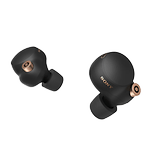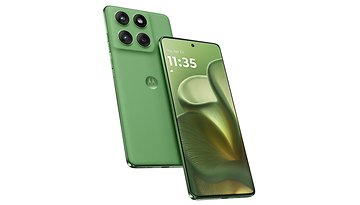Sony WF-1000XM4 review: What goes in the ear, stays in the head


Sony charges a whopping $279 for its new WF-1000XM4 wireless earbuds! The hugely convoluted model name that makes it difficult to reference in everyday conversation is nevertheless one of the most highly rated wireless earbuds around. As to whether I can sing similarly positive tunes about it after a week of daily use, why not find out in my review?
Good
- High-quality sound
- Great ANC performance
- Has LDAC and DSEE Extreme functions
- Very easy and convenient to use
- Up to 12-hour battery life
Bad
- Fit in ear takes a little getting used to
- No AptX (HD) support
- Sony needs to revamp their app
- 360 Reality Audio is cool to have but impractical

Conclusion: The best may be expensive
The Sony WF-1000XM4 is one of the most anticipated in-ear Bluetooth earbuds with ANC that you can pick up in June 2021, or if I dare venture, for the whole year! This is how I would sum up the conclusion in a single sentence. You might be surprised at how much I gush about the numerous positives that these Bluetooth earbuds offer, as well as Sony's attention to detail.
Make no mistake about it: Sony's new top-of-the-line wireless earbuds sound good, they deliver ANC on par with the over-ear alternative WH-1000XM4 and carry all of the premium features that one would expect from a high-end audio device in 2021. In addition, the battery life is excellent while it has also made progress in terms of design with a more compact charging case.
However, I do feel that the WF-1000XM4 did not always fit well in my ears. I also feel that Sony's app looks rather dated and needs a refresh, otherwise, it would tarnish the premium feel a little bit. Nevertheless, I would strongly recommend you pick up the WF-1000XM4 if you have $280 to spare for wireless earbuds that are as small as a glove of garlic, which also increases the risk of them getting lost if you're not careful.
Design & wearing comfort: Fit not always optimal
The Sony WF-1000XM4 can be considered as the wireless version of its classic in-ear headphones. This means the earbuds are held in your ears via earplugs without a retaining clip of any sort. A single earbud tips the scales at slightly less than 7 grams, while the included charging case weighs 41 grams. The case has shrunk in size compared to its predecessor.
What I liked:
- Modern design
- Smaller charging case
- High-quality workmanship
- IPX4 certification
What I disliked:
- Fit is not always optimal (more on this below)
- Ear tips protrude far into the ear
Visually speaking, you'll notice a difference between the WF-1000XM3 and the WF-1000XM4. Sony has managed to forge a new path for itself by making the round and circular design an iconic and instantly recognizable one. Herein lies the problem: there isn't much wiggle room when it comes to making it stand out from the rest of the crowd. Whether you like the design or not, is of course, a matter of taste.
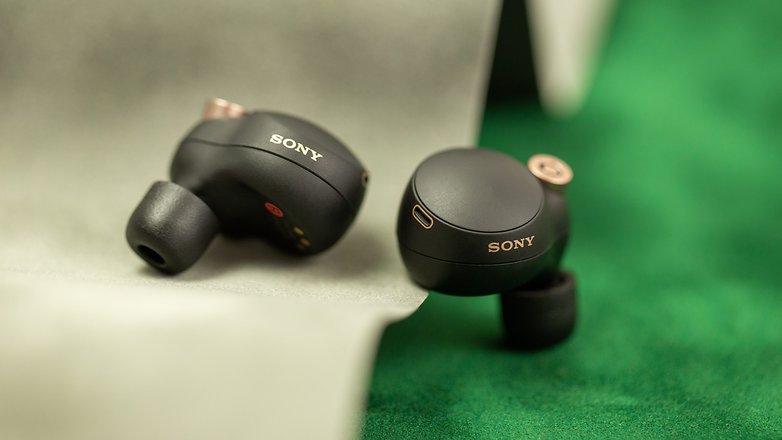
What cannot be denied, however, is that Sony has shrunk the charging case. Although the individual earbuds are rather large in size, the case measures just 6.5 x 3 x 3.5 centimeters (W x D x H). With a weight of 41 grams, it is hardly noticeable in my pockets or my hipster chest bag. Its bulkier predecessor actually made you aware of its presence whenever you carried it around, which might be a good thing if you're less careful with your belongings.
If it begins to rain while wearing them, you can also leave the WF-1000XM4 in your ear without any worries. They are protected against water splashes based on the IPX4 standard, and thus, making them suitable as sports headphones. Wearing it on my jogging route after three laps, the in-ear Bluetooth earbuds proved immaculate in delivering music and podcasts while I pounded the pavement.
Wearing comfort
And that brings us to the matter of wearing comfort, which didn't quite satisfy me at first. By default, Sony inserted the medium-sized earbud tips which were probably too large for my ear canals. It could also be the reason as to why they kept falling out, not to mention I also struggled with ear pain.
Since I couldn't achieve a secure fit, I stuffed the earbuds further into my ears where they must have ended up too deep in the process. What is sure to amuse the younger generation is the fact that I decided to downgrade the tips by one size. Do take note that Sony's app also provides a function to determine the optimal earbud tip size.
Despite relying on the app's recommendation, I still don't feel 100 percent confident walking around with the WF-1000XM4 in my ears. It may be a matter of preference, but the stem design complete with silicone tips of the Oppo Enco X makes me feel more secure when I am cycling and running. Perhaps the fear of losing them stems mostly from the high price of the WF-1000XM4.
TL;DR: Sony produced an excellent piece of eye candy with the WF-1000XM4. If you don't like the design, you can at least be happy about a smaller charging case. Wearing comfort could be better for my ears, but that's a matter of taste. Kudos for Sony's environmentally friendly packaging. Arigato gozaimasu, Sony-San!
Sound: I am now spoiled
Within the Sony WF-1000XM4 lie 6-millimeter drivers accompanied by high-performance neodymium magnets. They cover a frequency range of 20 to 40,000 Hertz if you make use of the high-quality LDAC audio codec. In addition, the earbuds support the DSEE Extreme standard with a 96-kHz sampling rate at 990 kilobits per second.
What I liked:
- Powerful and customizable sound
- High-quality audio codecs (LDAC & AAC)
- 360-degree sound put a big smile on my face
What I disliked:
- No AptX (HD)
- 360-degree sound feature won't be used often
- 5-band equalizer only and bass optimization
With high-quality drivers and the appropriate Bluetooth codecs, Sony has created the ideal conditions for high-quality sound on paper. While Apple equips its own music streaming service with a lossless feature and its own AirPods do not necessarily feature the necessary technical requirements for this, the WF-1000XM4 are technically equipped for Tidal, Amazon Music HD, and other similar services. This is attributed to LDAC and happens to be Sony's very own Bluetooth codec. Support for AptX, however, has been dropped this time around, as it was last offered by Sony with the WH-1000XM3. Apple fans, however, will have a smile on their faces with the AAC codec.
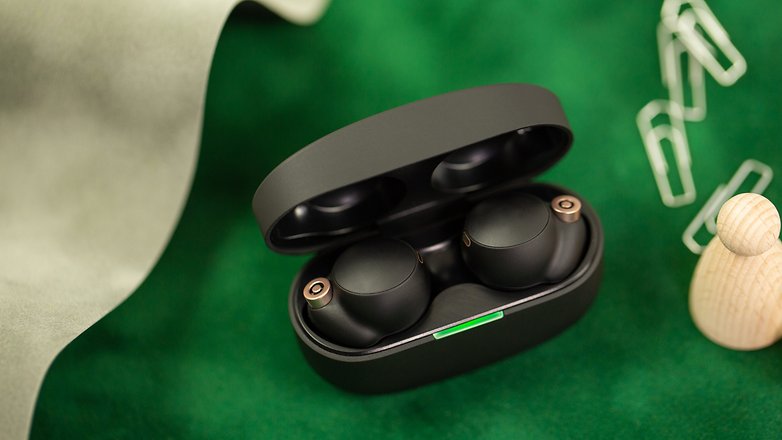
In my review, I subscribed to the premium music streaming service Tidal, which streams in MQA format at up to 4,608 kilobits per second at 96 kHz and in 24 bits. On Android 11, you can send the high streaming quality to the earbuds thanks to LDAC before optimizing the sound further with Sony's DSEE Extreme. While LDAC ensures particularly "dense" data when listening to music, DSEE Extreme optimizes the reproduction of the frequency responses that are lost when compressing the original sound source.
The result? Impressive sound quality, which is also aligned to Spotify Premium and without LDAC. The WF-1000XM4's drivers deliver plenty of power across all situations, and with a few tweaks to the equalizers in Sony's app, you'll be able to adapt the earbuds well to your listening habits.
On Spotify, you can find my review playlist for headphones and earbuds, where I break it down further into several genres. Despite the sound quality being consistent across genres, I still found myself gravitating towards jazz with Chick Corea entertaining me most of the time during the entire week. If I were to enjoy metal à la Gojira or Tyler, the Creator's juicy hip-hop beats also sounded classy. By the way, he released a new album on the day this review was published, so here's a listening tip if you're into metal! ?
360 Reality Audio is impressive, but rarely used
One feature that I don't want to leave unmentioned is Sony's 360 Reality Audio. This feature is best compared to Apple's 3D sound or of course, Dolby Atmos. The goal is to deliver a realistic surround sound experience to a pair of snoozy stereo earbuds. In order to activate the feature, you'll need to take a photo of your ears with your smartphone.
Sony will then analyze your ear structure and calculate how spatial sound would enter your ears. The fact that realistic surround sound is also possible with stereo headphones has been known at least since the virtual haircut based on binaural sound recordings, which can be heard on YouTube.
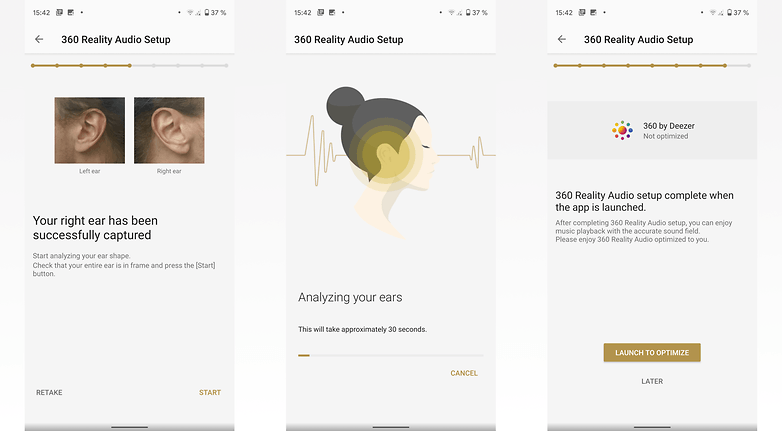
Sony also simulates surround sound based on your ear shape, and again, it needs the right audio source to achieve optimal results. Among other things, Tidal supports 360-degree audio recordings. When you unbox the earbuds, you can activate a free trial on Tidal, Deezer, or nugs.net via a coupon, albeit with only 20 tunes available in the Tidal catalogue. Unfortunately, that's not enough for Sony's technology to make the leap from tech demo to everyday use.
Deezer's dedicated 360 app offers a whole lot more, but the streaming service also costs $14.99 for the HiFi version. So after the three months of the free trial via Sony's coupon, it ends up as expensive fun.
That's not to say Sony's tech demo isn't fun and entertaining though. I found myself grinning in my apartment while listening to Foo Fighters' Everlong (on Tidal). That's something about this technology that triggered something in me that I have never felt in a very long time. If you were to close your eyes while listening to it, you would literally sink into the music as it happens around you. This is especially obvious after months of lockdown without live music, and that's somehow very cool.
Sound is adjustable thanks to a 5-band equalizer
I also have to point out the positives of Sony's sound optimization via its equalizer. Although you only have a 5-band equalizer at your disposal, it is extremely potent. In addition, there's also bass optimization and 10 presets to choose from in addition to two custom settings.
Based on an analysis of your hearing, such as using the excellent Soundcore app, is something that Sony misses out on. Fundamentally speaking, however, I would like to criticize the Sony app here. As an app companion for such an expensive audio product, I find Sony's app to be simply too old-fashioned and cumbersome to use.
Yes, the app shines with a number of functions and with a bit of familiarization, you can find your way around. But the app is simply too old-fashioned in its interface and doesn't offer a particularly good user experience in my opinion. Maybe you aren't too bothered by this, but after reviewing the Soundcore Life Q35, Sony's app stands out negatively in comparison.
TL;DR: The Sony WF-1000XM4 is technically and acoustically sound. In everyday use, modern standards such as DSEE Extreme and LDAC are particularly impressive, providing the high-quality drivers with the necessary material to show off its capability. All in all, they are as close to Hi-Fi headphones as far as wireless Bluetooth earbuds are concerned.
Noise cancellation: On par with Sony's over-ear models
Of course, Sony also equipped its WF-1000XM4 with active noise cancellation. In addition to the passive attenuation thanks to its foam earplugs, Sony also relies on its new V1 processor to send out even more precise and latency-free anti-noise. There's a transparency mode too, which can be enabled automatically if you so desire.
What I liked:
- ANC is very effective overall
- Ambient Sound Control works well
What I disliked:
- No adjustable ANC levels and works only in combination with ambient sound
- Transparency mode is very susceptible to wind
- Ambient Sound Control has annoying notifications by default
Sony is already experienced when it comes to ANC (Active Noise Cancellation), consistently making it to the top of best ANC lists, especially in its over-ear headphones. What the Sony WH-1000XM4 does, you will also obtain in a similar form with the in-ear models. In my opinion, the earbuds don't really have to hide behind the over-ears when it comes to ANC anymore.
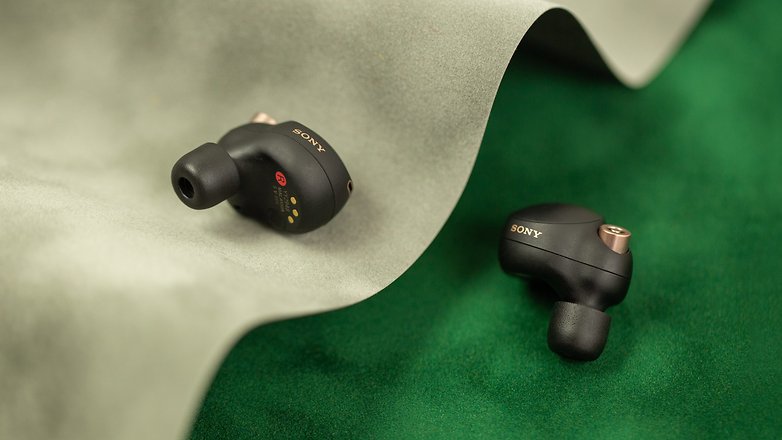
For example, when it comes to noise, traffic sound is almost completely filtered out. If you were to switch back and forth between the transparency mode (Ambient Noise Control) and ANC, you will receive an impression as if you were dipping your head underwater. This is pretty much typical for all ANC headphones and earbuds, however, sudden noises are also suppressed in a less effective manner.
Strictly speaking, Sony doesn't offer a gradual regulation of ANC. Instead, you can regulate the efficiency of the noise cancellation by enabling transparency mode. Sony has dubbed it as "Ambient Sound Control" and it offers another really cool comfort feature here.
Before I tell you about the wonders of Adaptive Sound Control, here is one more thing that I disliked about it. Although Sony offers a mode to reduce wind noise, it comes through very strongly in transparency mode. When riding my bike, I had to turn off Ambient Sound because the wind noise was too loud.
Adaptive Sound Control
But now for the cool feature, as with "Ambient Sound Control", the Sony app recognizes the movements of your smartphone. In doing so, the app will automatically switch between a few modes. For example, if you're sitting at your desk in the office, the ANC will completely block out the noise from annoying colleagues.
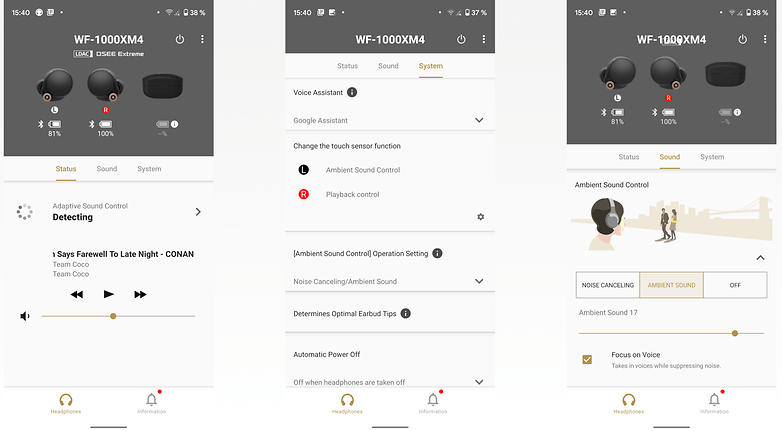
If you were to get up and don't want to miss any flirting opportunities on your way to the toilet, the earbuds will automatically switch to "walking" mode and turn on transparency mode with an optional focus on voices. The entire mechanism annoyed the heck out of me at first, as there was always a notification delivered to my smartphone and my music would go quiet briefly. You can turn the sound notification off though, and you can also configure locations with fixed settings if you don't need ANC such as when you are at home.
TL;DR: Sony's in-ear Bluetooth earbuds not only does ANC very well, but they also added clever features along the way. The Adaptive Sound Control is not the world's first, but it still knows how to deliver. The only thing I would like to see is better regulation of the ANC without transparency mode, as this is quite susceptible to wind noise.
Battery life: Up to 12 hours - or a full Rush song
You can listen to music with the WF-1000XM4 for 12 hours at a stretch, as long as you deactivate ANC. With noise cancellation enabled, the runtime drops to approximately eight hours. The charging case which also supports wireless charging contains enough power to deliver another 16 hours with ANC and another 24 hours without. Sony has also conveniently thought of including a quick-charging feature to boot.
What I liked:
- Very good battery life overall
- Quick-charging and wireless charging supported
- Discreet "battery low" announcement
What I disliked:
- Earbuds run out of juice at different times due to their individual charges
If you've read my short introduction above concerning the list of pros and cons, you would already know everything about the Sony WF-1000XM4's battery life. Having a battery life of up to 12 hours is outstanding in the in-ear Bluetooth earbuds market, and even with ANC enabled, you'll be able to make it through a full workday.
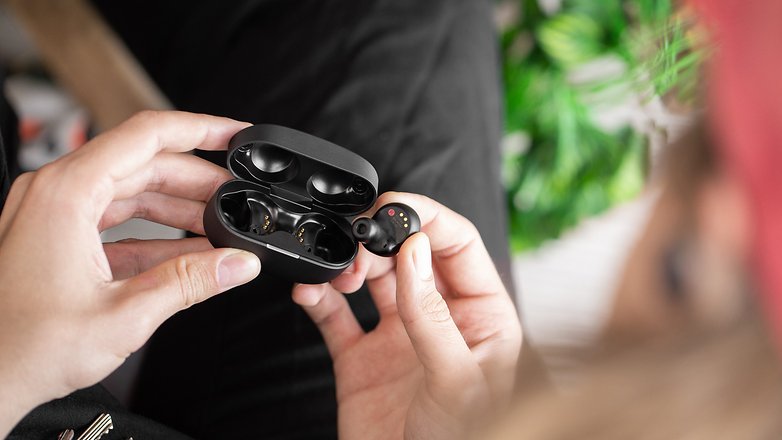
Do you want to go for a quick jog and notice that the headphones are running on empty? You can add an hour of music enjoyment in a matter of just five minutes thanks to Quick-Charging. This impressive feature is rounded off by the inclusion of convenient wireless charging. In terms of battery life, the only negative thing that I would have noticed is the individual earbuds sometimes have different battery levels. In everyday use, however, this is not a problem.
TL;DR: Runtime of up to 12 hours is definitely a strong point! The fact that Sony also thought of convenient features such as quick charging and wireless charging rounds off the whole thing. Kudos!
Sony WF-1000XM4 technical specifications
Specs at a glance
| Feature | Sony WF-1000XM4 |
|---|---|
| Size | 6.5 x 3 x 3.5 centimeters (case) | 2.8 x 2 x 3 centimeters (earbud) |
| Weight | 41 grams (case) | 7 grams (earbud) |
| Driver | 6 mm high-performance neodymium magnets |
| Frequency response | Max. 20 - 40,000 Hz |
| Bluetooth | Bluetooth 5.2 |
| ANC | Yes, with Sony's V1 processor |
| Bluetooth codecs | SCB, AAC, LDAC |
| Battery life | Up to 12 hours (NC off) | Up to 8 hours (NC on) |
| Extension via charging case | 24 hours (without ANC) |
| Features | DSEE Extreme, 360-degree sound, Google Assistant, Alexa, wear recognition, hands-free calling |
| Price | $279.99 |
What else you need to know about the WF-1000XM4
- For telephony, Sony uses beam forming microphones. The call quality still sounds a bit like you're talking on a hands-free device.
- The suppression of wind noise and background noise is excellent during conversations.
- Available in white and black colors.
Final verdict
Well, Sony, what else can I tell you? The company has really delivered with the WF-1000XM4! The sound quality is excellent, all modern standards and comfort features are on board. and the battery life is also above what the competition offers. Apart from that, I have heard better ANC on other models, but that is not to detract from the WF-1000XM4's ANC performance in any way.
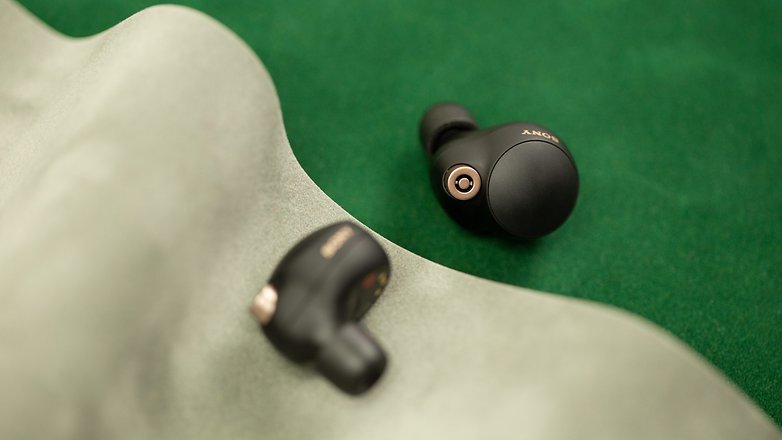
That doesn't mean you can't filter out ambient noise very well with the WF-1000XM4. Especially when you are listening to your favorite tunes, you might not hear an oncoming vehicle or train that could almost run you over in the very next instant. But thanks to technologies like Active Sound Control, Sony has taken care of such situations.
All things considered, the Sony WF-1000XM4 is the new gold standard for in-ear Bluetooth earbuds. However, I'm confident that other manufacturers won't sit still for long. Hence, I really look forward to the next few months when audiophiles bicker about what's to come and continue to compare new releases against the WF-1000XM4.
